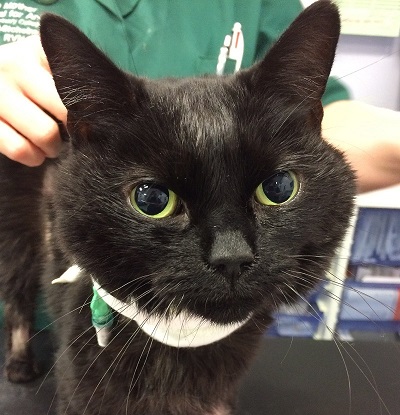New SUB Clinic at RVC
Clinical Connections – Summer 2019
Dr Rebecca Geddes, Lecturer in Small Animal Internal Medicine and co-head of the new SUB clinic, which is a collaboration between Soft Tissue Surgery and Internal Medicine
Upper urinary tract stones in cats appear to on the rise in the UK, and are often difficult to detect and diagnose. On average more than one cat per week presents to RVC Small Animal Referrals with ureteral obstruction and associated acute kidney injury.
Surgical management of ureteral obstruction was revolutionised by the development of the subcutaneous ureteral bypass device or SUB (Norfolk Veterinary Products), but placement of these devices requires specific training and cats continue to require close monitoring post-operatively.
At RVC Small Animal Referrals, we have launched a new SUB clinic, allowing us to cope with increasing case numbers. Expertise from two of our specialist services to ensure optimal case management.
The clinic is a unique collaboration between services and is headed up by Dr Zoe Halfacree from Soft Tissue Surgery and myself, from the Internal Medicine Service. Other members of both teams are also involved in helping run the clinic, which also has a dedicated surgery Registered Veterinary Nurse, Nadine Rogers.
The majority of cats with ureteral obstruction do not respond favourably to medical management and, therefore, emergency placement of a SUB provides an alternative route for urine flow. SUB placement is performed to save a cat’s life, with the intention of leaving the device in place permanently. However, SUBs require regular check-ups to ensure they are patent and no infection is present.
Cats with a SUB also need ongoing monitoring of their kidney function, as this has been shown to have the biggest impact on subsequent survival time.
In most cases, ureteral obstruction is caused by an ureterolith, but other causes include strictures, blood clots and masses. The underlying cause of upper urinary tract stones and the optimal way to prevent them from occurring is currently not well understood.

Tulip, a seven-year-old female neutered domestic short-haired cat presented to the RVC with right ureterolithiasis and severe azotaemia. She had survived a road traffic accident six years previously, but subsequently suffered from chronic
intermittent constipation. As is common in cats with upper urinary tract stones, she had hidden her condition extremely well.
During a visit for radiographs and deobstipation at her referring practice, she was noted to have ‘big kidney, little kidney’ syndrome, with multiple ureteroliths in the right ureter.
Tulip had an emergency referral to the RVC, in which ultrasound examination confirmed that the ureteroliths were causing obstruction, resulting in a dilated renal pelvis of 0.6cm. Her left kidney was small (2.6cm) with lack of corticomedullary definition, possibly due to a historic ureteral obstruction that went unnoticed.Tulip was severely azotaemic, with a serum creatinine concentration of 1081umol/l, but despite this, she remained bright and alert.
Tulip’s owners elected for her to undergo surgical management, and surgeons from our Soft Tissue Surgery Service performed a laparotomy and SUB placement under fluoroscopic guidance, with no major complications.Tulip was confirmed to have negative urine cultures at the time of SUB placement.
Postoperatively,Tulip’s serum creatinine concentration normalised – and remained stable at 145umol/l six months later. She was bright and active at home and her constipation was being well-managed with oral medications. She continues to do well 18 months later and is bright and active.
One of the keys to Tulip’s success was that the ureteral obstruction was detected and a SUB placed before complete irreversible nephron destruction occurred. As seen for Tulip, cats can hide signs of illness, ureteral obstruction and azotaemia, often making it difficult to diagnose this condition. At RVC Small Animal Referrals we are happy to discuss any cases of cats with incidental upper urinary tract stones, or possible ureteral obstructions. Any cases where ureteral obstruction is suspected require urgent assessment and treatment.
